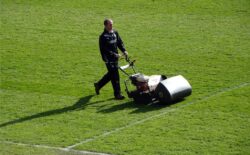The best time to overseed Kentucky Bluegrass is in early fall, specifically from August to mid-October.
This timing capitalizes on cooler air temperatures and warm soil, which are ideal conditions for seed germination and establishment without the heavy competition from weeds.
Spring, from March to Mid-June, offers a secondary window for overseeding, especially for addressing winter damage.
However, the optimal success rate and easier establishment conditions make fall the preferred season.
Key Steps for Successful Overseeding of Kentucky Bluegrass
1. Preparation:
Before overseeding, ensure the lawn is mowed to a lower height and debris is removed to improve seed-to-soil contact. For compacted soil, aeration may be beneficial.
2. Choosing the Right Time:
Aim for the early fall period. If overseeding in spring, ensure it’s early enough to allow grass to establish before the heat of summer.
3. Soil Contact:
Raking or using a slit seeder can improve contact between the seeds and the soil, essential for germination.
4. Watering:
Keep the soil consistently moist after overseeding to support seed germination without causing waterlogging.
5. Maintenance:
Post-germination, switch to deeper, less frequent watering to encourage deep root growth. Mow the lawn when new grass is about 3 inches tall.
FAQs on Overseeding Kentucky Bluegrass
Q: Why is fall the best time for overseeding Kentucky Bluegrass?
A: Fall offers ideal growing conditions with less weed competition and optimal soil temperatures, allowing grass to establish before winter.
Q: Can I overseed Kentucky Bluegrass in spring?
A: Yes, spring is the second-best time for overseeding, especially for repairing winter damage, but be mindful of the potential summer heat impacting young grass.
Q: How do I ensure good seed-to-soil contact?
A: Use a rake or slit seeder to loosen the top layer of soil before overseeding, which helps seeds settle and germinate more effectively.
Q: How often should I water newly overseeded areas?
A: Water daily or as needed to keep the soil moist until seeds germinate, then gradually reduce frequency to encourage deeper root growth.
Q: When can I mow the overseeded areas?
A: Wait until the new grass reaches about 3 inches in height before the first mow to ensure it’s well-established.
In Summary
- Overseed Kentucky Bluegrass in early fall or spring for best results.
- Prepare the lawn properly to improve seed-to-soil contact.
- Maintain consistent moisture for germination, then adjust as the grass establishes.
Sources and Further Reading
- For comprehensive advice on Kentucky Bluegrass care, Pennington’s guide provides insights into overseeding and lawn maintenance.
- Swell Seed Co. offers detailed recommendations on choosing Kentucky Bluegrass for overseeding projects.
- Nature’s Seed discusses techniques for patching and overseeding lawns with bluegrass seed, ensuring successful lawn improvement efforts.



